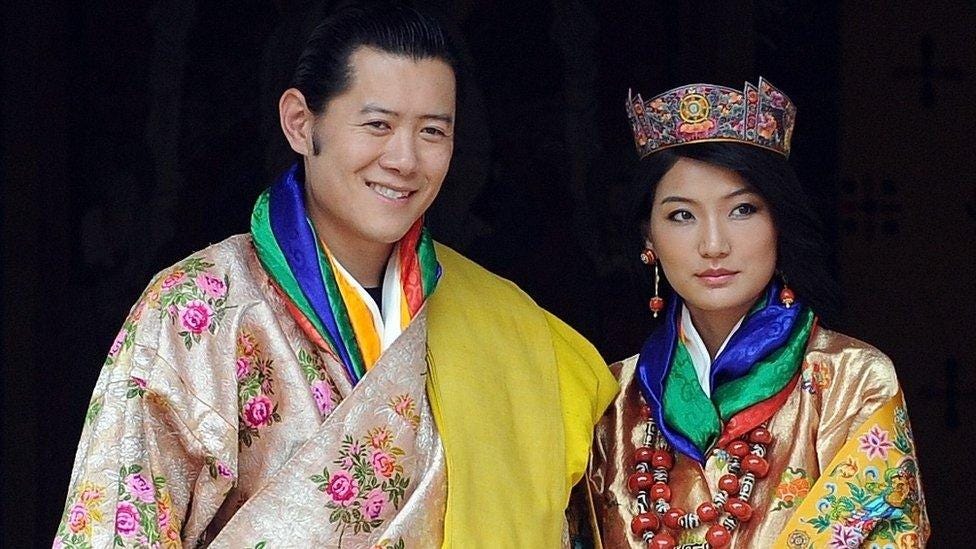Bhutan country profile
Bhutan is a tiny and remote kingdom nestling in the Himalayas between its powerful neighbours, India and China.
Bhutan is a tiny and remote kingdom nestling in the Himalayas between its powerful neighbours, India and China.
Almost completely cut off for centuries, it has tried to let in some aspects of the outside world while fiercely guarding its ancient traditions.
The Bhutanese name for Bhutan, Druk Yul, means "Land of the Thunder Dragon" and it only began to open up to outsiders in the 1970s.
The Wangchuck hereditary monarchy has wielded power since 1907. But Bhutan became a two-party parliamentary democracy after elections in March 2008.
KINGDOM OF BHUTAN: FACTS
Capital: Thimphu
Area: 38,394 sq km
Population: 777,400
Language: Dzongkha
Life expectancy: 68 years (men) 71 years (women)
LEADERS
Head of state: King Jigme Khesar Namgyel Wangchuck
Jigme Khesar Namgyel Wangchuck succeeded his father, Jigme Singye Wangchuck, in December 2006 after the former monarch announced his abdication.
His predecessor had already given up some of his absolute powers in 1998 and ruled in conjunction with the government, an assembly and a royal advisory council.
Prime minister: Lotay Tshering
Lotay Tshering has been Bhutan's prime minister since the November 2018 national assembly elections, when his Bhutan United Party won the majority of the seats, defeating the governing People's Democratic Party of Prime Minister Tshering Tobgay.
MEDIA
Television did not come to Bhutan until 1999. For years, the country cut itself off, fearing that outside influences would undermine its monarchy and culture.
Radio broadcasting began in 1973 and the internet arrived in 1999.
TIMELINE
Some key dates in the history of Bhutan:
Image caption,
Bhutan has had limited exposure to the outside world
1720 - Chinese imperial army invades and temporarily establishes control over Bhutan.
1772-73 - British intervention.
1864-65 - Further intervention by Britain.
1907 - Ugyen Wangchuck is chosen as hereditary ruler.
1910 - Treaty giving Britain control over foreign relations.
1949 - Treaty signed with newly-independent India guaranteeing non-interference in Bhutan's internal affairs, but allowing Delhi influence over foreign relations.
1958 - Slavery abolished.
1974 - First foreign tourists allowed in.
1988 - Census leads to branding of many ethnic Nepalis as illegal immigrants. Government also introduces other measures to stress Tibetan-based Bhutanese culture, antagonising minority ethnic Nepali community.
1990 - Violent ethnic unrest and anti-government protests in southern Bhutan pressing for greater democracy and respect for Nepali rights. Thousands of ethnic Nepalis flee to Nepal.
1998 - King cedes some powers to national assembly.
1999 - Limited television and internet services allowed; several dozen political prisoners released.
2007 - Bhutan signs a landmark agreement with India which revises ties with its neighbour, giving Bhutan more say over its foreign and defence policies.
2013 - Prime Minister Tshering Tobgay says Bhutan's much lauded concept of Gross National Happiness is overused and masks real problems such as increasing debt, chronic unemployment, poverty and corruption.
Image caption,
Melting glaciers caused by climate change are a growing concern in Bhutan
The BBC
Overview
Bhutan's economy is primarily reliant on agriculture, hydropower, tourism, and forestry. Agriculture, especially subsistence farming, forms the backbone of livelihood for a significant portion of the population. Hydropower, particularly the generation and export of electricity, is a major contributor to the economy. Tourism, while currently facing challenges, is also a key sector.
Here's a more detailed look:
Agriculture:
About 56% of the population depends on agriculture, which includes both farming and animal husbandry.
Hydropower:
Bhutan possesses substantial hydropower potential, and the export of electricity to India is a significant revenue source.
Tourism:
Tourism contributes substantially to the economy and is a major employer, but has been impacted by the COVID-19 pandemic.
Forestry:
Bhutan's forests are a valuable resource, and forestry plays a role in the economy.
Industry:
Industrial production is primarily focused on cottage industries due to the mountainous terrain.
Services:
The service sector also contributes to the economy, with a significant portion of the population working in this area.
Economic Growth:
Bhutan has experienced robust economic growth in recent decades, driven by hydropower and other factors, though growth has been impacted by the pandemic.
India's Influence:
Bhutan's economy is closely linked to India, with strong trade and monetary ties.
Challenges:
The mountainous terrain poses challenges to infrastructure development, and the economy faces challenges like economic diversification and adapting to changing global conditions.
Economy of Bhutan
Article Talk
The economy of Bhutan is based on agriculture and forestry, which provide the main livelihood for more than 60% of the population. Agriculture consists largely of subsistence farming and animal husbandry. Rugged mountains dominate the terrain and make the building of roads and other infrastructure difficult. Bhutan is among the richest by gross domestic product (nominal) per capita in South Asia, at $3,491 as of 2022, but it still places 153rd, and among the poorest in the world. The total gross domestic product is only $2.898 billion, and 178th according to IMF.
Economy of
Bhutan
Thimphu is the largest economic centre of Bhutan.
Currency
ngultrum (BTN)
Indian rupee (INR)
Fiscal year
1 July – 30 June
Trade organizations
SAFTA
Country group
Developing/Emerging
Lower middle income economy
Statistics
Population
Increase 780,000 (2021)
GDP
Increase $3.42 billion (nominal; 2025)
Increase $14.11 billion (PPP; 2025)
GDP rank
165th (nominal; 2025)
160th (PPP; 2025)
GDP growth
Increase 4.8% (2022)
Increase 5.0% (2023)
Increase 4.0% (2024f)
Increase 7.0% (2025f)
GDP per capita
Increase $4,300 (nominal; 2025)
Increase $17,110 (PPP; 2025)
Source: Wikipedia








